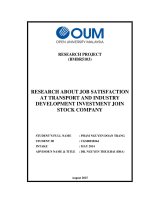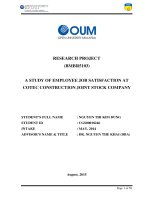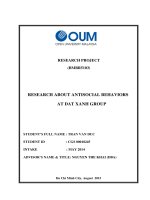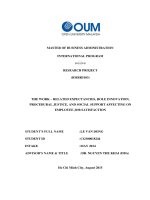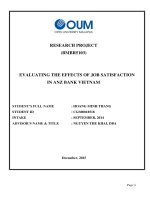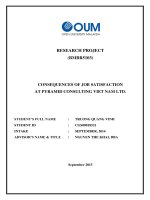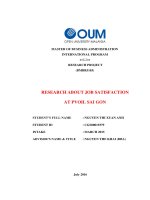Research about job satisfaction at HD bank
Bạn đang xem bản rút gọn của tài liệu. Xem và tải ngay bản đầy đủ của tài liệu tại đây (1.26 MB, 57 trang )
MASTER OF BUSINESS ADMINISTRATION
INTERNATIONAL PROGRAM
RESEARCH PROJECT
(BMBR5103)
RESEARCH ABOUT JOB SATISFACTION
AT HD BANK
STUDENT’S FULL NAME
: TRAN NGUYEN THY CHAU
STUDENT ID
: CGS00019363
INTAKE
: MARCH 2015
ADVISOR’S NAME & TITLE
: DR. KHAI NGUYEN
Ho Chi Minh City, July 2016
ADVISOR’S ASSESSMENT
..…………………………………………………………………………………………………………
..…………………………………………………………………………………………………………
..…………………………………………………………………………………………………………
..…………………………………………………………………………………………………………
..…………………………………………………………………………………………………………
..…………………………………………………………………………………………………………
..…………………………………………………………………………………………………………
..…………………………………………………………………………………………………………
..…………………………………………………………………………………………………………
..…………………………………………………………………………………………………………
..…………………………………………………………………………………………………………
..…………………………………………………………………………………………………………
ADVISOR’S SIGNATURE
..…………………………………………………………………………………………………………
(August 2016)
..…………………………………………………………………………………………………………
..…………………………………………………………………………………………………………
..…………………………………………………………………………………………………………
NGUYEN THE KHAI (DBA)
ACKNOWLEDGMENTS
Suggestions have been received from many of my lecturer and classmate during
research progress.
Each of those who have offered comments and suggestions always has my thanks.
The efforts of many people are needed to develop and improve this research.
Among these people are the reviewers and consultants who point out areas of
concern, cite areas of strength, and make recommendations for change.
I am grateful for the outstanding support from my lecturer NGUYEN THE KHAI
(DBA) and HDBank for allowing the employees to answer the questions in the
survey and support too much information related to my research.
And, I also specially thank to my members of family, friends and colleagues who
always mobilize me to finish this research.
Once again, I appreciate very much to all.
Tran Nguyen Thy Chau, Student
CONTENTS
ABSTRACT ...................................................................................................................1
PART ONE: INTRODUCTION ..................................................................................2
About HDBank ............................................................................................................2
Organization structure and corporate culture .............................................................. 6
Organization structure: ............................................................................................. 6
Corporate culture:.....................................................................................................6
Research problem statement ........................................................................................ 7
Research objectives ......................................................................................................7
Research scope .............................................................................................................8
Significance of research ............................................................................................... 8
PART TWO: LITERATURE REVIEW .......................................................................... 9
Definition of Constructs............................................................................................... 9
Overall Job Satisfaction ........................................................................................... 9
Satisfaction with My Supervisor ..............................................................................9
Person-Organization Fit ........................................................................................... 9
Fairness in Skill-based Pay .................................................................................... 10
Work Tension .........................................................................................................11
Argument for the relationship among the constructs .................................................11
X theory and Y theory ............................................................................................ 11
Maslow’s theory .....................................................................................................13
Alderfer’s ERG theory ........................................................................................... 15
McClelland’s theory ............................................................................................... 16
Herzberg’s two-factor theory .................................................................................18
Hackman and Oldham's Job Characteristics .......................................................... 20
Hypotheses .................................................................................................................22
Research Model .........................................................................................................22
PART THREE: METHODS ............................................................................................. 23
Data collection ...........................................................................................................23
Design template scale ............................................................................................ 23
PART FOUR: RESULTS ................................................................................................... 30
Cronbach’s Alpha ......................................................................................................30
Cronbach’s Alpha of constructs .............................................................................30
Statistics information .................................................................................................32
Descriptive statistics .............................................................................................. 32
Correlation statistics .............................................................................................. 33
Hypotheses testing .....................................................................................................34
Hypothesis proposed (H1)...................................................................................... 34
PART FIVE: CONCLUSIONS ......................................................................................... 38
Discussion .................................................................................................................. 38
Limitation of research ................................................................................................ 38
Forecast recommendation .......................................................................................... 39
REFENRENCES .................................................................................................................. 40
APPENDIX ............................................................................................................................ 42
Appendix 1: Survey ...................................................................................................42
Appendix 2: Presentation ........................................................................................... 48
FIGURE & TABLE
Figure 1: Maslow's hierarchy of needs, represented as a pyramid with the more basic
needs at the bottom ........................................................................................................14
Figure 2: Alderfer’s ERG theory ................................................................................... 16
(Source: www.springerplus.com/content/2/1/246/figure/F2?highres=y) ...................... 16
Figure 3: McClelland’s theory....................................................................................... 17
Figure 4: Herzberg’s two-factor theory .........................................................................19
Figure 5: Hackman and Oldham's Job Characteristics .................................................. 21
Figure 6: Research Model of Job Satisfaction ............................................................... 22
(Table 1: Person-Organization Fit Scale) ......................................................................24
(Table 2: Satisfaction with My Supervisor Scale)......................................................... 24
(Table 3: Fairness in Skill-based Pay Scale) .................................................................25
(Table 4: Overall Job Satisfaction Scale) ......................................................................26
(Table 5: Work tension Scale) ....................................................................................... 27
(Table 6: Time table for data collection progress) ........................................................ 28
(Table 7: Description of interviewees) ..........................................................................29
(Table 8: Cronbach’s Alpha - Internal Consistency)..................................................... 30
(Table 9: Cronbach’s Alpha of Overall Job Satisfaction) .............................................30
(Table 10: Cronbach’s Alpha of Satisfaction with My Supervisor) .............................. 31
(Table 11: Cronbach’s Alpha of Person-Organization Fit) ...........................................31
(Table 12: Cronbach’s Alpha of Fairness in Skill-based Pay) ......................................31
(Table 13: Cronbach’s Alpha of Work Tension)........................................................... 32
(Table 14: Descriptive statistics) ................................................................................... 32
(Table 15: Correlation statistics) ................................................................................... 33
(Table 16: Model summary of H1) ................................................................................34
(Table 17: Coefficients of H1) ...................................................................................... 34
(Table 18: Model summary of H2) ................................................................................35
(Table 19: Coefficients of H2) ...................................................................................... 35
(Table 20: Model summary of H3) ................................................................................36
(Table 21: Coefficients of H3) ...................................................................................... 36
(Table 22: Model summary of H4) ................................................................................37
(Table 23: Coefficients of H4) ...................................................................................... 37
Business Research Methods
P a g e 1/51
ABSTRACT
This purpose of this research is way to find the factors influence to the Job Satisfaction
of employees working at HDBank.
This research project will use Business Research Methods to determine Job
Satisfaction and what other main factors that it influence job satisfaction. And this
research also was conducted by quantitative method with source data is surveys that it
issued by offline to 500 employees of HDBank to collect the ideas and comments of
employees about job satisfaction.
Next, the result of these surveys shall be statistically analyzed by software SPSS
version 22 (copyright of IBM). Hypotheses used this research includes five constructs:
one dependent construct (Job Satisfaction) and four independent constructs
(Satisfaction with My Supervisor, Person-Organization Fit, Fairness in Skill-based
Pay and Work Tension)
I expect that the results of this research will help the CEO; managers of HDBank to
have some reference aspect in human resource management to improve and increase
our quality resource based on job satisfaction of employees as well as you should have
perception clearly that job satisfaction of employees will impact to working effective,
ability of competitiveness of HDBank in Vietnamese banking system.
Key words in this research: Global Job Satisfaction, Satisfaction with My Supervisor,
Person-Organization Fit, Fairness in Skill-based Pay, Work Tension and HDBank.
Student: Tran Nguyen Thy Chau (ID: 19363)
Business Research Methods
P a g e 2/51
PART ONE: INTRODUCTION
About HDBank
History:
Ho Chi Minh City Development Joint Stock Commercial Bank, abbreviated as
HDBank, was founded on 04th January, 1990; with its present head office based at 25
Bis Nguyen Thi Minh Khai, District 1, Hochiminh City. HDBank is one of the
pioneering joint stock commercial banks in Vietnam. Its typical shareholders are Viet
Nga Insfrastructure Investment Corporation – SOVICO Holdings, Hochiminh Finance
and Investment state-owned Company – HIFU, Tan Thuan Industrial Promotion
Company – IFC, Thuduc Housing Development Corporation – Thuduc House, Saigon
Real Estate Corporation – RESCO, Saigon Trading Group – SATRA, etc.
As one of the top 10 commercial banks in Vietnam with more than 25 years of
experience in Vietnam and currently advancing to the world, HDBank possesses the
financial capacity, advanced technology and flexible services which can satisfy the
demands of customers from various sectors, including individuals, corporation and
investors. The bank has standardised its branch model and been creating professional
and friendly standards for its customer service to realise its mission "committed to
your best returns and community development".
With strength of merger from DaiABank and HDFinance in the year of 2013, HDBank
became one of the largest lenders in Vietnam. The bank has a chartered capital of
VND 8.1 trillion and manages total assets of VND 100 trillion, a staff over 6.000
personnel. HDBank has expanded into a network of over 220 offices and 3,000
transaction spots with an eye on opportunities to open branches overseas. In the
international market, HDBank has established relations with more than 300 banks and
branches in over 150 countries and territories.
For these activities, HDBank has received many awards, prizes in domestic and many
international honours, such as "Best Cash Management in Vietnam" awarded by
Asiamoney and Euromoney.
Student: Tran Nguyen Thy Chau (ID: 19363)
Business Research Methods
P a g e 3/51
With a recent burst of growth, the bank has been able to build momentum and lay the
foundation to rise to new heights.
In July 2015, HDBank has about 220 sales points covering major economic centers
such as Ho Chi Minh City, Hanoi, Dong Nai, Binh Duong, Ba Ria - Vung Tau, Binh
Phuoc, Tay Ninh, DakLak, Gia Lai, Kon Tum, Lam Dong, Binh Thuan, Khanh Hoa,
Binh Dinh, Quang Ngai, Da Nang, Thua Thien - Hue, Ha Tinh, Nghe An, Thanh Hoa,
Quang Ninh, Hai Phong, Lang Son, Bac Ninh, Hai Duong, Lao Cai, Long An, Vinh
Long, Can Tho, Soc Trang, Ca Mau, Dong Thap, An Giang, KienGiang...
Major Awards
•
President's Certificate of Merit
•
The National Quality Award as conferred by the Prime Minister
•
Viet Nam's Top 500 Biggest Enterprises
•
Viet Nam's Strong Brand Award
•
For-the-Community-Development Award
•
Sustainable Brand Award
•
World Payment Management Prize (conferred by Citigroup)
•
Standard Payment Telegram Making Quality Award (conferred by Wells Fargo
Bank, N.A)
•
Outstanding International Payment Prize (awarded by Citibank)
•
The head emulation flag in movements
•
The best Savings Bank Award in 2011
•
Certificate of merit as conferred by the Prime Minister
•
Union Emulation flag for strong excellent enterprises
•
“The excellent annual report" of Vision Awards 2010 conferred by League of
American Communications Professionals (LACP)
•
The best Cash Management of Vietnam conferred by Asiamoney
Scope busines:
HDBank’s business operations include:
Student: Tran Nguyen Thy Chau (ID: 19363)
Business Research Methods
P a g e 4/51
Mobilizing capital (short-term, mid-term, long-term in different methods such
as limited, unlimited and certificates of deposits (CD)
Receiving investment and development capital from national organizations
Borrowing from another credit institutions
Lending (short-term, mid-term, long-term)
Discounting commercial papers, bonds
Executing interbank payment service
Trading foreign currencies, bullion in domestic and foreign markets according
to international standard
Conducting international payment transactions
Mobilizing capital from foreign countries
Implementing other banking services in accordance with foreign banks.
Development strategy and investment:
Accomplish the restructuring program; build up a sound management system based on
high-tech utilization, sustainability and full compliance with relevant laws and
regulations…
+ Expand network coverage and its efficiency.
+ Execute the retail banking strategy
+ Develop the model of investment bank with the core divisions are Funding and
Currency Trading under the support of securities companies, fund management
companies, etc.
+ Develop profitable financial investment plans and diversify financial investment
models.
+ Build a professional and consistent brand for the whole system as well as develop
HDBank as a strong brand in banking and finance.
Student: Tran Nguyen Thy Chau (ID: 19363)
Business Research Methods
P a g e 5/51
Vision, Missions and Core values
Vision:
HDBank aspires to become the most effective financial group operating in Vietnam
with an international network and a brand name that our Vietnamese clients are proud
to be associated with.
Missions:
HDBank aims to provide premium, international standard financial products and
services, which best meet our clients' diverse needs.
Core values
HDBank is a client-focused firm, which strives to operate with maximum efficiency
and
transparency
to
ensure
our
clients
assets
are
protected
safely.
They are committed to employing dynamic and talented personnel, who show a
constant spirit for self-improvement.
They aim to co-operate and grow with partners on further shared developments.
They recognize the importance of their shared responsibilities with the local
community and society at large
Contact
Legal name:
Headquarters: 25 Bis Nguyen Thi Minh Khai street, District 1, HCMC
Phone: (08) 62 915 916
Fax: (08) 62 915 900
Email:
Student: Tran Nguyen Thy Chau (ID: 19363)
SWIFT code: HDBCVNVX
Website www.hdbank.com.vn
Business Research Methods
P a g e 6/51
Organization structure and corporate culture
Organization structure:
Corporate culture:
HDBank is proud to be constantly evolving with the aim of creating a dynamic and
professional working environment.
To create and maintain the workplace in this style, they place a great emphasis on the
relationship between their management and staff members. They aim to create an
environment where they can nurture talent while ensuring their staff members enjoy
good treatment and equal career opportunities.
Student: Tran Nguyen Thy Chau (ID: 19363)
Business Research Methods
P a g e 7/51
HDBank aims to form a dynamic and efficient organization that has an in-depth
understanding of their products and services, their personnel will perform their duties
in accordance with a strict code of professional ethics while prioritizing clients’ and
the bank’s interests.
They encourage their staff’s curiosity, creativity and desire to develop their talents and
further their careers.
They also encourage their staff to show a high level of responsibilities and
commitment in spreading harmony and goodwill amongst the community.
Research problem statement
Job satisfaction in HDBank is always a big concern among its Board of Directors
because they clearly consider that only satisfied employees can help their organization
to be successful.
Currently, in the context of severe economic environment in Vietnam, especially in the
banking system nowadays, HDBank has faced a tough competition with other
commercial banks in the field. Therefore, to maintain the position of top brand in
banking sector, HDBank always aims to create the highest satisfaction among
employees to help organization to operate more efficiently; increase quality of
products and services; build brand awareness, customer trust and loyalty… But, some
factors such as Satisfaction with Supervisor, Fairness in skill-based Pay, PersonOrganization Fit and Work tension are problems for human resource management at
HDBank.
Research objectives
This purpose of this research is the way to find the factors which affect to the Job
Satisfaction of employees working at HDBank.
My research will focus on 3 main matters:
Firstly: searching for related information and trying to define what the meaning
of Job Satisfaction is of employees at HDBank
Student: Tran Nguyen Thy Chau (ID: 19363)
Business Research Methods
P a g e 8/51
Secondly: designing the research model and testing with related factors to
check the influences between these factors to access strong / weak level of each
factor in the progress
Thirdly:
discussing
and
proposing
recommendation
to
improve
the
effectiveness and forecasting the human resources management at HDBank in
the future
Research scope
The scope of research is for the entire employees at HDBank, including: General
Director, Vice General Directors, managers at each branch, subordinate and employees
working at HDBank; it does not include: Chairman, Board of Directors, Shareholder,
Supervisory Board, and employees are under probation period or in maturity leave.
The survey scope is within the territory of Vietnam, which includes 500 employees of
HDBank.
The contents of this research are only including factors influencing to Job Satisfaction
at HDBank; it does not have intention of re-structuring, changing and replacing the
employees.
This survey was conducted from 1st August 2015 to 25th May 2016.
Significance of research
The result of this research is being conducted in order to have an understanding of the
factors influencing the Job Satisfaction in organization. It will help the management
of the company to have a strong view of problems that affected the skilled employees
in the company. This research could also support as a reference for other managers to
improve the working environment according to the result of the analysis from the
research. With the research results, management of HDBank could re-arrange the
policy and set out a strategy to obtain its methods by creating better thinking on Job
Satisfaction.
Student: Tran Nguyen Thy Chau (ID: 19363)
Business Research Methods
P a g e 9/51
PART TWO: LITERATURE REVIEW
Definition of Constructs
Overall Job Satisfaction
It was developed by Cammann, Fichman, Jenkins (1983). It includes 3 items.
The concept of job satisfaction has been developed in many ways by many different
researchers and practitioners. One of the most widely used definitions in
organizational research is that of Locke (1976), who defines job satisfaction as “a
pleasurable or positive emotional state resulting from the appraisal of one's job or job
experiences”. Others have defined it as simply how content an individual is with his or
her job; whether he or she likes the job or not. It is assessed at both the global level or
at the facet level.
Job satisfaction can also be seen within the broader context of the range of issues
which affect an individual's experience of work, or their quality of working life. Job
satisfaction can be understood in terms of its relationships with other key factors, such
as general well-being, stress at work, control at work, home-work interface, and
working conditions.
Satisfaction with My Supervisor
It was developed by Scarpello and Vandenberg (1987), describes an employee’s
satisfaction with his or her immediate supervisor. It includes 4 items.
Supervisor always affect the employees, subordinates. The impact is reflected in the
treatment, support, reward, motivate, encourage and support... Satisfaction with their
supervisor is increasing, the working efficiency of organizations increasing.
Person-Organization Fit
It was developed by Bretz and Judge (1994), describes the formal and informal
developmental experiences a job affords employees. It includes 7 items.
Person–organization fit (P–O fit) is the most widely studied area of person–
environment fit, and is defined by Kristof (1996) as, "the compatibility between people
and organizations that occurs when (a) at least one entity provides what the other
needs, (b) they share similar fundamental characteristics, or (c) both". High value
congruence is a large facet of person–organization fit, which implies a strong culture
Student: Tran Nguyen Thy Chau (ID: 19363)
Business Research Methods
P a g e 10/51
and shared values among coworkers. This can translate to increased levels of trust and
a shared sense of corporate community (Boone & Hartog, 2011). This high value
congruence would in turn reap benefits for the organization itself, including reduced
turnover, increased citizenship behaviors, and organizational commitment (Andrews et
al., 2010; Gregory et al., 2010). The attraction–selection–attrition theory states that
individuals are attracted to and seek to work for organizations where they perceive
high levels of person–organization fit (Gregory et al., 2010). A strong person–
organization fit can also lead to reduced turnover and increased organizational
citizenship behaviors (Andrews, Baker, & Hunt, 2010)
Fairness in Skill-based Pay
It was developed by Lee, Law, and Bobko (1998). The Skill-based Pay (SBP) system
was pioneered by Procter and Gamble in the late 1960s and started to be applied
increasingly by various organizations since then. However, the existing literature about
SBP or competency-based pay is very limited and does not provide sufficient guidance
regarding its impact on organizational and employee effectiveness. Most of the
existing studies on SBP followed either case study or exploratory survey approaches
that lack generalization and analytical rigor (Murray & Gerhart, 1998). In order to
understand the appropriate conditions for effective application of SBP and its
outcomes, there is a need for studies that use rigorous research methods and theoretical
models. There is no SBP design that can work for every organization. Instead, the best
design should be determined by a complete analysis of the work activities,
organizational culture, and the available human, technical, and financial resources. A
pay system in general should be tailored to fit the technical system and the social
system in the organization (Ledford & Bergel, 1991). This is particularly important
when the pay system is relatively new and not commonly used as in the case of SBP.
An important issue here is to analyze the existing organizational culture and the degree
of readiness in accepting the change implied in adopting an SBP system. The lack of
previous knowledge and experience of SBP system by both employees and managers
entails careful planning in ensuring a smooth transition to the new pay system. It is
very important to inform, involve and continuously communicate with employees, to
Student: Tran Nguyen Thy Chau (ID: 19363)
Business Research Methods
P a g e 11/51
ensure their understanding, acceptance and participation in the process of planning,
designing and implementing the SBP system. It includes 4 items.
Work Tension
It was developed by House and Rizzo (1972), describes an employee’s psychological
or psychosomatic symptoms associated with tension experienced at work. It includes 7
items.
Job tension is define as an ‘adverse reaction people have to excessive pressures or
other types of demand placed on them’.3 Work-related stress is thus understood to
occur when there is a mismatch between the demands of the job and the resources and
capabilities of the individual worker to meet those demands. This definition
emphasises the relationship between individuals and their working environment, and
helps to explain why a situation that one person regards as a stimulating challenge
causes another to experience a damaging degree of stress.
Argument for the relationship among the constructs
X theory and Y theory
Contents
Theory X and Theory Y are theories of human motivation that were created and
developed by Douglas McGregor at the MIT Sloan School of Management in the
1960s. These theories describe two contrasting models of workforce motivation that
have been used in human resource management, organizational behavior,
organizational communication and organizational development.
X theory and Y theory have to do with the perceptions that managers hold of their
employees, which in turn influence their management style.
X theory: according to this theory, X type individuals are considered to be inherently
lazy and not fond of their jobs. As a result, an authoritative management style is
required to ensure that individuals fulfill their objectives. Workers managed this way
need to be closely supervised and comprehensive systems of control need to be
developed. A hierarchical structure is needed with narrow span of control at each and
every level. According to this theory, employees will show little ambition without an
Student: Tran Nguyen Thy Chau (ID: 19363)
Business Research Methods
P a g e 12/51
enticing incentive program and will avoid responsibility when they can. According to
Dr. Kumi Mark, if the organizational goals are to be met, X theory managers must rely
heavily on the threat of punishment to gain compliance of employees. When practiced,
this theory can lead to mistrust, highly restrictive supervision and a punitive
atmosphere. The X theory manager tends to believe that all actions can be traced back
and the individual responsible for them needs to be directly rewarded or reprimanded
depending on the action's results. This managerial style is more effective when used to
motivate a workforce that is not inherently motivated to perform. It is usually
exercised in professions where promotion is infrequent, unlikely or even impossible
and where workers tend to perform repetitive tasks in their jobs. One major flaw of
this management style is that it limits the potential of the employees under it and
discourages out of the box thinking.
Y theory: in this theory, management assumes employees can be ambitious, selfmotivated and exercise self-control. It is believed that employees enjoy their mental
and physical work duties. According to them, work is as natural as play. They possess
the ability for creative problem solving, but their talents are underused in most
organizations. Y theory managers believe that given the proper conditions, employees
will learn to seek out and accept responsibility, exercise self-control and self-direction
in accomplishing objectives to which they are committed. Y theory manager believes
that, given the right conditions, most people will want to do well at work. They believe
that the satisfaction of doing a good job is a strong motivation. Many people interpret
Y theory as a positive set of beliefs about workers. A close reading of The Human
Side of Enterprise reveals that McGregor simply argues for managers to be open to a
more positive view of workers and the possibilities that this creates. He thinks that Y
theory managers are more likely than X theory managers to develop a climate of trust
with employees required for employee development. This would include managers
communicating openly with subordinates, minimizing the difference between superiorsubordinate relationships, creating a comfortable environment in which subordinates
can develop and use their abilities. This environment would include sharing of
decision making so that subordinates have a say in decisions that influence them.
Student: Tran Nguyen Thy Chau (ID: 19363)
Business Research Methods
P a g e 13/51
X theory and Y theory combined: X and Y theory are not different ends of the same
continuum, but rather two different continua in themselves. McGregor has identified X
theory and Y theory differently. X theory assumptions are that individuals dislike their
careers. X theory people have to be supervised. Y theory assumptions are that
individuals like their careers and are willing to take part in responsibility. Y theory
people don't need supervision and can be expected to be productive in their jobs.
Previous research
Sahin, F. (2012). “The mediating effect of leader-member exchange on the
relationship between X and Y theory management styles and effective commitment: A
multilevel analysis”. Journal of Management and Organization, 18 (2), 159–174.
Self-argument
Personally, I think Theory X and Theory Y will have a strongly impact to PersonOrganization Fit, because it helps us to have a clear perception of employees’
characteristics in organizations. After that, it affects Job Satisfaction.
Maslow’s theory
Contents
Maslow's hierarchy of needs is a theory in psychology proposed by Abraham Maslow
in his 1943 paper “A Theory of Human Motivation" in Psychological Review”.
Maslow subsequently extended the idea to include his observations of humans' innate
curiosity. His theories parallel many other theories of human developmental
psychology, some of which focus on describing the stages of growth in humans.
Maslow used the terms “physiological”, “safety”, “belongingness” and “love”,
“esteem”, “self-actualization” and “self-transcendence” to describe the pattern that
human motivations generally move through.
Maslow studied what he called exemplary people such as Albert Einstein, Jane
Addams, Eleanor Roosevelt, and Frederick Douglass rather than mentally ill or
neurotic people, writing that “the study of crippled, stunted, immature, and unhealthy
specimens can yield only a cripple psychology and a cripple philosophy”. Maslow
studied the healthiest 1% of the college student population.
Student: Tran Nguyen Thy Chau (ID: 19363)
Business Research Methods
P a g e 14/51
Maslow's theory was fully expressed in his 1954 book Motivation and Personality. The
hierarchy remains a very popular framework in sociology research, management
training and secondary and higher psychology instruction.
Figure 1: Maslow's hierarchy of needs, represented as a pyramid with the more basic needs at the bottom
(Source:research
www.honolulu.hawaii.edu/intranet/committees/FacDevCom/guidebk/teachtip/maslow.htm)
Previous
Tang, T. L.; Ibrahim, A. H.; West, W. B. (2002). “Effects of war-related stress on the
satisfaction of human needs: The United States and the Middle East”. International
Journal of Management Theory and Practices 3 (1): 35-53.
Cianci, R.; et al (2003). “Maslow's hierarchy of needs: Does it apply in a collectivist
culture”. Journal of Applied Management and Entrepreneurship 8 (2): 143-161.
Kenrick, D. T.; Griskevicius, V.; Neuberg, S. L.; Schaller, M. (2010). “Renovating the
pyramid of needs: Contemporary extensions built upon ancient foundations”.
Perspectives on Psychological Science 5 (3): 157-163.
Self-argument
Student: Tran Nguyen Thy Chau (ID: 19363)
Business Research Methods
P a g e 15/51
Personally, I think Maslow’s theory is affecting to Job Satisfaction, Satisfaction with
Supervisor, because it deeply researched into the nature of human beings in all aspects
of psychology and physiology.
Alderfer’s ERG theory
Contents
Clayton Paul Alderfer (born September 1, 1940 in Sellersville, Pennsylvania) is an
American psychologist who further developed Maslow's hierarchy of needs by
categorizing the hierarchy into his ERG theory (Existence, Relatedness and Growth).
The existence group is concerned with providing the basic material existence
requirements of humans. They include the items that Maslow considered to be
physiological and safety needs. The second group of needs is those of relatedness - the
desire people have for maintaining important interpersonal relationships. These social
and status desires require interaction with others if they are to be satisfied, and they
align with Maslow's social need and the external component of Maslow's esteem
classification. Finally, Alderfer isolates growth needs: an intrinsic desire for personal
development. These include the intrinsic component from Maslow's esteem category
and the characteristics included under self-actualization.
Alderfer categorized the lower order needs (Physiological and Safety) into the
Existence category. He fit Maslow's interpersonal love and esteems needs into the
Relatedness category. The Growth category contained the self-actualization and selfesteem needs. Alderfer also proposed a regression theory to go along with the ERG
theory. He said that when needs in a higher category are not met then individuals
redouble the efforts invested in a lower category need. For example if selfactualization or self-esteem is not met then individuals will invest more effort in the
relatedness category in the hopes of achieving the higher need.
Student: Tran Nguyen Thy Chau (ID: 19363)
Business Research Methods
P a g e 16/51
Figure 2: Alderfer’s ERG theory
(Source: www.springerplus.com/content/2/1/246/figure/F2?highres=y)
Previous research
C.A. Arnolds and C. Boshoff (2002). “Compensation, esteem valence and job
performance: an empirical assessment of Alderfer's ERG theory”. The International
Journal of Human Resource Management.
Self-argument
Personally, I think Alderfer's ERG theory has greater scientific support than Maslow’s
theory but both theories remind managers of the types of reinforces or rewards that can
be used to motivate people.
McClelland’s theory
Contents
Written by psychologist David McClelland, is a motivational model that attempts to
explain how the needs for achievement, power, and affiliation affect the actions of
people from a managerial context. This model was developed in the 1960s soon after
Student: Tran Nguyen Thy Chau (ID: 19363)
Business Research Methods
P a g e 17/51
Maslow's hierarchy of needs in the 1940s. McClelland stated that we all have these
three types of motivation regardless of age, gender, race, or culture. The type of
motivation that each individual is driven by is changed by life experiences and the
opinions of their culture.
Figure 3: McClelland’s theory
(Source: www.mindtools.com/pages/article/human-motivation-theory.htm)
Previous research
Harrell, Adrian M.; Stahl, Michael J. (1981). “A behavioral decision theory approach
for measuring McClelland's trichotomy of needs”. Journal of Applied Psychology, Vol
66 (2), 242-247
Self-argument
Personally, I think McClelland’s theory has shown that when a manager needs to work
with others culture, he will need to adjust to see that the demand for Job Satisfaction is
quite different from one person to another.
Student: Tran Nguyen Thy Chau (ID: 19363)
Business Research Methods
P a g e 18/51
Herzberg’s two-factor theory
Contents
The two-factor theory (also known as Herzberg's motivation-hygiene theory and dualfactor theory) states that there are certain factors in the workplace that cause job
satisfaction, while a separate set of factors cause dissatisfaction. It was developed by
psychologist Frederick Herzberg, who theorized that job satisfaction and job
dissatisfaction act independently of each other.
Two-factor theory fundamentals: Attitudes and their connection with industrial mental
health are related to Abraham Maslow's theory of motivation. His findings have had a
considerable theoretical, as well as a practical, influence on attitudes toward
administration. According to Herzberg, individuals are not content with the
satisfaction of lower-order needs at work; for example, those needs associated with
minimum salary levels or safe and pleasant working conditions. Rather, individuals
look for the gratification of higher-level psychological needs having to do with
achievement, recognition, responsibility, advancement, and the nature of the work
itself. This appears to parallel Maslow's theory of a need hierarchy. However,
Herzberg added a new dimension to this theory by proposing a two-factor model of
motivation, based on the notion that the presence of one set of job characteristics or
incentives leads to worker satisfaction at work, while another and separate set of job
characteristics leads to dissatisfaction at work. Thus, satisfaction and dissatisfaction
are not on a continuum with one increasing as the other diminishes, but are
independent phenomena. This theory suggests that to improve job attitudes and
productivity, administrators must recognize and attend to both sets of characteristics
and not assume that an increase in satisfaction leads to decrease in un-pleasurable
dissatisfaction.
Student: Tran Nguyen Thy Chau (ID: 19363)
Business Research Methods
P a g e 19/51
Figure 4: Herzberg’s two-factor theory
(Source: www.strategicleadershipinstitute.net/news/start-with-herzberg-if-motivation-lacks-at-work/)
Previous research
Robert J. House and Lawrence A. Wigdor (2006). “Herzberg's dual-factor theory of
job satisfaction and motivation: A review of the evidence and a criticism”. Personnel
Psychology, Vol 20 (4), 369-390.
King, Nathan (1970). “Clarification and evaluation of the two-factor theory of job
satisfaction”. Psychological Bulletin, Vol 74 (1), 18-31.
Self-argument
Personally, I think Herzberg’s two-factor theory has shown that the factors that
encourage good if addressed will create satisfaction from that motivate employees to
work very hard, harder. But if not resolved, it creates good condition is not satisfied,
but not necessarily cause discontent. Meanwhile factor for maintaining well if not
resolved will create resentment, if solved would create states not unhappy with the
situation but not satisfied.
Student: Tran Nguyen Thy Chau (ID: 19363)

